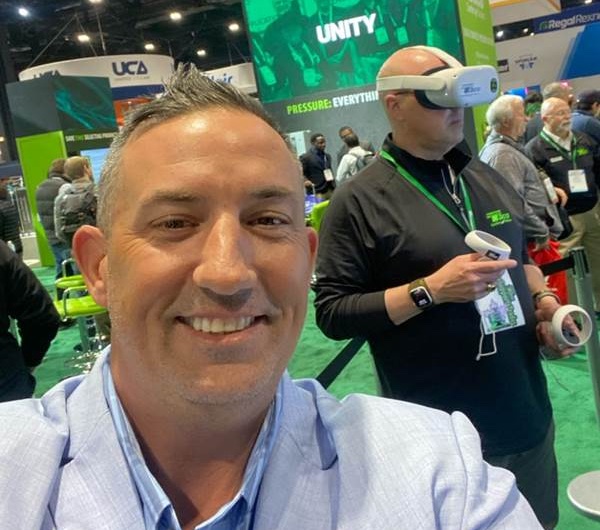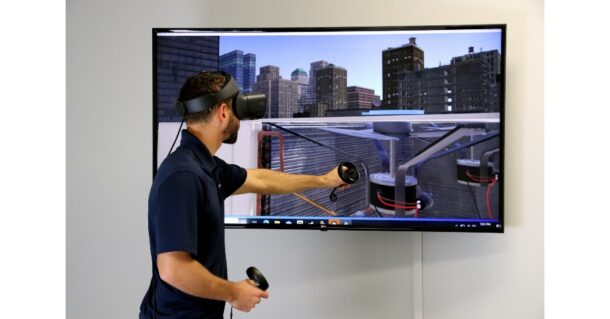Virtual and simulation training isn’t necessarily new to the industry but its acceptance has been met with intrigue, and trepidation. But to say that this is the future of training? Not so fast. The consensus thoughts regarding this type of training is that will never replace in-person or on-the-job training, but it will become a Read more
Interplay Learning

Virtual and simulation training isn’t necessarily new to the industry but its acceptance has been met with intrigue, and trepidation. But to say that this is the future of training? Not so fast. The consensus thoughts regarding this type of training is that will never replace in-person or on-the-job training, but it will become a cog in the overall “wheel” for training assets.
According to Taco Comfort Solutions’ Product & Application Instructor-East, Dave Holdorf, Taco doesn’t want to change its training necessarily, rather seek to enhance the training experience.
“We ask many attendees how we can improve our classes and seminars. One of the most frequent replies is: ‘Add a hands-on section to the class; the theory is great and useful, but I want to install.’
“In a classroom setting, this can sometimes be difficult for the space needed, the time it takes, and to accommodate the different skillsets of attendees. We believe we’re now on a track with virtual reality (VR) training to give that experience to attendees—whether they’re seasoned pros, or new to the trade. VR can help to guide participants in what to look for, and more importantly what not to do on a project,” says Holdorf.

F.W. Webb’s Michael DelConte checks out the VR display at the Taco booth during the AHR Expo.
Ken Midgett, former teacher and apprenticeship Instructor, Lehigh Career & Technical Institute, now Plumbing, Marketing Director with Interplay—whose mission statement is “Better Careers Better Lives”—believes that they can play a part in a person’s career trajectory with that person using Interplay’s content. “When a person engages in learning and increases both their fundamental knowledge and the steps to do a task, we are helping that person upskill and creating more career opportunities for them. The value of a product that interplay offers is the demand function. You do not have to wait until a class is offered you can just connect and learn,” says Midgett.
Adaptation to simulation and on-demand training is paramount to success for the learner and the business. Midgett says that traditional classroom learning for skilled trades is becoming more and more challenging for several reasons:
- Finding good instructors: Many think that because they know a skill, they can teach it effectively. As a former educator, this is not always the case. This leads to poor instruction and marginal learners who are not engaged.
- The cost: The cost of running and maintaining a hands-on training center is much higher than instructor salaries and consumables.
- Change or die: Young learners are not inept at learning from lectures. Most skilled trade learners need to be engaged with learning and it must represent meaningful learning.
- The disruption of classroom learning to the workday: A rationale for going to class in the evening for 2-3 hours is losing traction to young learners. Business owners become frustrated with learning times and days as they view this as unproductive time. Young learners need to be met where they are with training that fits their lifestyle.
Interplay Learning training, combined with the new employee with the right attitude who is coachable and willing to learn, can be an explosive combination with a win-win result. “Taking an apprentice and having them spend time training and learning with on-demand training and then pushing that person into the field with a skilled person to watch and do in the real world is the best way to train this person or persons at scale,” says Midgett, who says there are numerous other advantages to this model:
- On-job efficiency increases as the apprentice now possesses the foundational knowledge and skills to perform a given task.
• Relationships are better between the journeymen and the apprentice, as the journeyman perceives the apprentice as engaged and productive.
• Business owners experience low turnover, better culture, and increased revenue as these new hires have direction and are leaning at scale.
• Technicians feel confident in their work due to training and upskilling.
• Callbacks are reduced and remediation training for the technician to increase their confidence
• Service managers can focus on coaching and maintaining technician stats instead of being the only technical lifeline for numerous techs.
• When sending these apprentices to “factory training,” they can engage and understand this much better due to the foundational knowledge.
Nonetheless, Midgett says there are a few things to note and understand about simulation and on-demand training:
• On-the-job or hands-on training with higher skilled supervision cannot be replaced.
- Simulations are great at teaching steps and muscle memory of a task.
- Simulation or any on-demand training cannot teach “feel.” As an example, simulation training cannot teach the skill of what “tight” feels like with a pair of wrenches on threaded steel piping or how tight to make a tank-to-bowl connection on a closet, or how tight a screw should be on the control board. This is what the onsite skilled person or journeyman must understand and teach effectively on site.
“While VR, AR and simulation-based technology are great resources, I do not think that any one particular learning system or style is the future,” says Rich Camacho, CEO & Co-Founder, BlueRecruit. Having said that, Camacho utilizes Interplay’s services (all of Interplay’s certifications and courses live on BlueRecruit, and when a person completes an Interplay course, they can then add that qualification to their BlueRecruit profile to strengthen their profile for Employer) and he thinks Interplay is a fantastic tool to augment in-class learning and a great launch point for someone either just entering the trades or seeking to upskill a particular technique.
“However, at the end of the day true craft mastery will occur in the field with a wrench. As technology continues to improve and costs continue to decline, Interplay will play a larger and larger part of building the next generation of skilled trades professionals and we’re excited to work alongside them in building “Better Careers and Better Lives,” says Camacho.

Training provider Interplay Learning introduces new scalable out-of-the-box programs that help learners gain skills for in-demand jobs and connect with employers Interplay Learning, the leading provider of immersive skilled trades training, today announced Interplay Academy, an out-of-the-box, easy to implement trades certificate program that provides education and workforce development organizations the tools to take learners Read more
Training provider Interplay Learning introduces new scalable out-of-the-box programs that help learners gain skills for in-demand jobs and connect with employers
Interplay Learning, the leading provider of immersive skilled trades training, today announced Interplay Academy, an out-of-the-box, easy to implement trades certificate program that provides education and workforce development organizations the tools to take learners from zero trades skills to job-ready.
With Interplay Academy, novice learners can now get accessible, high-quality online trades education with a clear pathway to gain skills in their chosen field, earn industry certifications, and connect with employers to confidently take on in-demand entry-level roles.

“Interplay Academy’s Job-Ready Certificate Programs represent a significant leap forward in skilled trades education where there is a shortage of qualified skilled labor,” said Doug Donovan, CEO and founder, Interplay Learning. “Our holistic approach provides a direct pathway to job-readiness, empowering educators and workforce development program administrators with the tools needed to pave the way to future careers for learners. We believe these programs will play a pivotal role in developing a pipeline of talent for the skilled trades workforce of the future.”
Interplay Academy’s Job-Ready Certificate Programs in HVAC, Electrical, Plumbing, Residential Construction, Multi-Family Maintenance, Building Maintenance, and Appliance Repair feature a flexible, expert-led curriculum, recognized by the Department of Labor, to effectively prepare today’s digital-first learners to enter the workforce. Leveraging Interplay’s award-winning immersive 3D simulations, video content and industry certifications, these programs ensure a diverse range of learners can build and reinforce foundational skills through self-paced, unlimited hands-on practice in a safe, virtual environment.
Each certificate program includes a simple, out-of-the-box implementation that provides the tools and support for educators and administrators to launch and track a scalable program with ease. Expert guidance built into the learning content and live engagement managers successfully prepare learners for future careers without the need to hire on-staff industry experts or build expensive infrastructure.
In addition to earning an Interplay Learning Job-Ready Certificate, learners enrolled in Interplay Academy’s programs can earn industry-recognized certifications, including NATE Ready-to-Work certification, OSHA 10 or 30 certifications, and EPA 608 certification, enhancing a graduate’s employability. Learners, who may need additional assistance choosing a career path, can take advantage of the programs’ career exploration tool to align their chosen path to their interests and career aspirations. When a learner completes the program, they can connect with employers through Interplay Learning’s partnership with BlueRecruit, a leading job platform for skilled trades professionals.
For more information about Interplay Academy’s Job-Ready Certificate Programs, please visit https://www.interplaylearning.com/training-academy/.

The leading provider of immersive learning for the trades celebrates 2023 milestones, including the industry’s first AI-powered mentor, a robust tech-driven apprenticeship program and enhanced safety training Interplay Learning, the leading provider of immersive skilled trades training, confirmed its position as the preferred provider for comprehensive, forward-thinking training in 2023 with a series of notable Read more
The leading provider of immersive learning for the trades celebrates 2023 milestones, including the industry’s first AI-powered mentor, a robust tech-driven apprenticeship program and enhanced safety training
Interplay Learning, the leading provider of immersive skilled trades training, confirmed its position as the preferred provider for comprehensive, forward-thinking training in 2023 with a series of notable new offerings and achievements, including the launch of the industry’s first AI-powered mentor for learning and skill development.
“We made enormous strides in serving the urgent training and workforce development needs of the skilled trade industries in the last 12 months, and we’ll only be accelerating the pace in 2024,” said Doug Donovan, founder and CEO of Interplay Learning. “Our immersive solutions empower individuals and organizations and help unlock valuable new opportunities, serving employers, workforce development agencies and educational institutions as well as young people entering the workforce and experienced skilled trades workers looking to advance their careers.”

In June, Interplay’s Intelligence Lab, a team of experts shaping the future of training by delivering innovative and intelligent solutions for the skilled trades, introduced Skill Advisor and Mentor (SAM), the industry’s first AI-powered mentor for learning and skill development. SAM helps technicians gain skills faster and more efficiently by taking a holistic approach to learning, asking questions and providing context so learners comprehend the content and sharpen their critical thinking skills.
In recognition of its groundbreaking potential to transform skilled trades training, SAM has been named the winner of the 2024 AHR Innovation Award for software. The AHR Innovation Awards recognize the year’s most inventive and original solutions, based on innovative design, creativity, application, value and market impact as judged by an independent panel of experts.
Interplay Learning’s commitment to helping organizations build a better-trained workforce is reflected in the company’s technology-driven apprenticeship program, which helps employers in the skilled trades enhance recruitment and increase employee retention while eliminating the traditional complexities of managing their own formal apprenticeship program. Participating in Interplay Learning’s DOL Apprenticeship Program allows companies to implement award-winning digital training that pairs on-the-job learning with immersive 3D simulations and video courses. Apprentices gain new skills, learn effective troubleshooting, and get unlimited hands-on practice, all in a safe virtual environment using a desktop, laptop, tablet, or virtual reality headset.
Interplay Learning also expanded its leading selection of safety training in 2023, including new OSHA training offerings and an innovative driving safety program designed to protect workers and minimize risk on the job. Overall, Interplay Learning created 112 new courses in 2023 to continue meeting the evolving needs of customers and their teams.
Key customer relationships in 2023 highlight Interplay Learning’s effectiveness for a wide variety of organizations:
- The Temperature Control Institute (TCI), a unique state-of-the-art skilled trades education program helping underemployed youth in Memphis and the surrounding area prepare for rewarding careers, relies on Interplay Learning’s immersive training programs. Together, Interplay and TCI develop skilled, job-ready talent, helping students turn their lives around and meet the labor needs of employers throughout the region.
- At Warren Central High School in Vicksburg, Mississippi, Interplay Learning enhances the career technical educational program, helping fast-track students’ hands-on introduction to career pathways in the construction industry. Through the partnership, ninth-grade students can accelerate their CTE education by engaging with Interplay Learning’s immersive 3D virtual-reality simulations and training content before starting the school’s full construction program in 10th grade.
- Southern Home Services Corporation, a leading residential home services provider specializing in HVAC, plumbing, electrical and generator service, replacement and maintenance, selected Interplay Learning as the exclusive content engine for technical training across the company’s growing network of more than 750 technicians. By leveraging Interplay’s cutting-edge digital learning platform, technicians at every business location will have seamless access to industry-leading training tools and resources, including immersive 3D simulations and virtual reality experiences.
“We’re proud of our accomplishments in 2023 and excited about all the opportunities ahead of us in 2024,” Donovan said. “We’re working with companies that are taking bold new approaches to learning and reshaping the possibilities of training and workforce development. Together, we have opportunities to truly transform the industries and people we serve.”

Career Training to Members of Detroit’s Gun Violence Reduction Program Interplay Learning, the leading provider of immersive skilled trades training, announces a transformative partnership with C.H.O.I.C.E.S (Choosing Honorable Options Increasing Chances to Establish Success), a community-based violence intervention program dedicated to reducing gun violence in Detroit as part of Mayor Mike Duggan’s “Detroit at Work” program Read more
Career Training to Members of Detroit’s Gun Violence Reduction Program
Interplay Learning, the leading provider of immersive skilled trades training, announces a transformative partnership with C.H.O.I.C.E.S (Choosing Honorable Options Increasing Chances to Establish Success), a community-based violence intervention program dedicated to reducing gun violence in Detroit as part of Mayor Mike Duggan’s “Detroit at Work” program. C.H.O.I.C.E.S is using Interplay Learning’s virtual reality and simulation-based training to empower at-risk youth and individuals affected by gun violence. Interplay’s innovative training equips them with valuable skills that open doors to a brighter future through sustainable employment in high-demand fields like HVAC, Plumbing, Electrical, Multifamily Maintenance, and Facilities Maintenance.

Aligning with C.H.O.I.C.E.S’ mission to empower violence-affected and/or justice involved individuals with practical job-ready skills, Interplay’s experiential videos, interactive 3D simulations, and immersive virtual reality courses complement the program’s existing in-person residential construction classes. Participants can now tailor their learning experience to align with their specific needs, schedules, and interests by taking the C.H.O.I.C.E.S in-person residential construction classes and/or Interplay’s online skilled trades courses. Using Interplay, learners can access 400+ hours of courses and hands-on simulations so they can practice their skills in a safe, realistic environment. They can leverage Interplay’s courses for as long as needed to prepare for industry certifications, secure meaningful employment with local employers, and ensure long-term success on their journey to self-sufficiency.
“We absolutely love Interplay,” said Stephanie Nixon, Chief Program Officer at Detroit at Work. “It complements our in-person learning well, and their team is great to work with. Our program participants are totally engaged; they’re having fun while learning, they’re competing with one another to complete courses, and all the while, it’s changing the trajectory of their lives.”
A critical feature of the training platform is the administrator reporting tools that enable program coordinators to identify participants who need help and provide timely support and intervention to those individuals. This proactive approach ensures participants stay on course with their training paths, bringing them closer to their ultimate goal of gaining employment and contributing positively to their communities.
“Our mission is to help institutions build better training, better careers, and better lives,” said Doug Donovan, founder and CEO of Interplay Learning. “C.H.O.I.C.E.S is making significant strides in reducing gun violence in Detroit and empowering individuals to lead fulfilling lives. We’re proud to partner with them to support the at-risk and underserved community with an innovative strategy that builds flexible pathways to meaningful trades careers.”

We’re going to talk about a painful topic,” Callbacks”. I bet I just made the hair stand up on the back of your neck. After being a contractor for 23-plus years and speaking to contractors daily, one of the most proverbial pain points in owning a contracting business is callbacks. Callbacks can be highly frustrating Read more
We’re going to talk about a painful topic,” Callbacks”. I bet I just made the hair stand up on the back of your neck. After being a contractor for 23-plus years and speaking to contractors daily, one of the most proverbial pain points in owning a contracting business is callbacks. Callbacks can be highly frustrating, a waste of valuable time, increase technician turnover, very expensive for the company, and in some cases, the loss of a customer. Throughout this article, will talk about dissecting the cause, and I will give you four steps you can implement to reduce them.
If we break callbacks into four categories; human error, manufacturer defects, lack of training, and inadequate operations it will be much easier to identify a rationale to track them. We are all human and prone to make some mistakes and even the best manufacturers have some defective products that find their way to the wholesaler’s shelf. Training is one of the best areas to maximize your efforts as it improves technician confidence which customers will immediately notice when speaking to them. A company-wide training culture also creates validation that a tech fully understands the product “before” being asked to service or install products. Operations afford owners and managers to be transparent with their techs when an event occurs and how to prevent them from moving forward. Using technology can help mitigate callbacks by bringing consistent operations to the top of mind, customer communication, and customer specifics, when techs are in the field.

Human Error
Unless the mistake is repetitive, or constantly not following company operations, human error is a hard one to have a resolution for. Good coaching, knowing and interacting with your techs, and being transparent with technicians are some of the best procedures to help with human error. Look at the data and see if there is a pattern. Perhaps something is happening with that senior tech outside of work that is causing the errors at work. Tracking the errors by the technician and job type is a best practice to reduce them.
Manufacture Defects
Contractors attempting to get paid for a manufacturer defect is challenging. We all know most times if a product fails under the warranty period, it will replace the part but not pay for any of the labor. Even on a DOA (dead on arrival) issue, this policy stays true however, there are exceptions. The key takeaway for handling defective products is to track them. Tracking them gives you the availability to see trends and make adjustments to the product or manufacture. It’s also worth noting to differentiate between the product and the tech doing the work. Specifically, make sure it is the product and not an install or service procedure the tech is not doing correctly. Once you track how many manufacturing defects you see in the course of the year, then calculate and it should become a line item in your pricing structure as a cost of doing business. Yes, this is a normal expense item that is a cost to run a business. Large corporations operate this way as they know there will be mistakes and contracting is no different.
Operations
Constantly monitoring and adjusting your operations can play a role in reducing callbacks. There are numerous CRM’s that help automate tracking the data to make adjustments. Data like trends in a job type, what products were used, which tech did the work, and the amount of time the tech was on the call. Automation also helps to mitigate confusion between the customer, dispatcher, and the original call. Defining and adjusting operations that affect callback mitigation is key to reducing them company-wide. Be completely transparent with company procedures between the technicians and their manager as to what happens when there is a callback.
Training
Teachable and trainable moments on an individual and company-wide basis can be produced through callbacks. Decide if there is one tech or several techs on a given call type having callbacks. If it’s several techs on the same callback, bring them together and reinforce the training on the hows and whys and just as importantly track the outputs of the training efforts. Make the adjustments from the group to individualized training accordingly if the callbacks persist with one technician. If the callback is from an individual and it’s identified as a training issue, assign or implement the training and as an interim, use your CRM to prevent that tech from doing the call type until it is confirmed the tech thoroughly understands the original mistakes made. Providing, implementing, and tracking training for your tech is one guaranteed way to mitigate technical and operational mistakes that lead to callbacks. In the fast-paced business environment, numerous contractors don’t value training or implementation of activity at the level it should be. There are other, less expensive options available to contractors to use a training tool instead of traditional brick-and-mortar training models. Digital and virtual reality software is available at one-third the price per technician. This training can be done asynchronously and not affect workflows and scheduling. All of the metrics are available to track the progress of a technician’s performance against the training activity assigned to a technician and help with callback mitigation.
There you have it! Implement and or refine these four tactics in your business and you will start to reduce some of your callbacks. It should be noted that one of the impacts of a callback not mentioned in this writing is the financial impact and opportunity costs of a callback on the company’s bottom line. Look for a breakdown and explanation of that in future articles. Happy Contracting!
 Guest Blogger: Ken Midgett, has been in the plumbing and heating industry for over four decades. He has worked in every facet of the plumbing and heating industry. He has owned two successful PHCC businesses, is a licensed Master Plumber, a two-time national award-winning educator for plumbing and heating CTE classrooms, with a 100 percent placement into the industry for all eligible seniors from his program. Ken was noted throughout the CTE industry for the inclusion of non-traditional workers in his classroom, including young women. He has placed several of those young women in the workforce. Ken is passionate about the skilled trades and he continues to stay active in PHCCNA and PHCCPA. Ken is the current president of his local PHCCLV association. This role has allowed him to continue mentoring and coaching young apprentices in the field. He is currently employed at Interplay Learning as the Plumbing Market Director. You can follow Ken at www.linkedin.com/in/kenmidgett.
Guest Blogger: Ken Midgett, has been in the plumbing and heating industry for over four decades. He has worked in every facet of the plumbing and heating industry. He has owned two successful PHCC businesses, is a licensed Master Plumber, a two-time national award-winning educator for plumbing and heating CTE classrooms, with a 100 percent placement into the industry for all eligible seniors from his program. Ken was noted throughout the CTE industry for the inclusion of non-traditional workers in his classroom, including young women. He has placed several of those young women in the workforce. Ken is passionate about the skilled trades and he continues to stay active in PHCCNA and PHCCPA. Ken is the current president of his local PHCCLV association. This role has allowed him to continue mentoring and coaching young apprentices in the field. He is currently employed at Interplay Learning as the Plumbing Market Director. You can follow Ken at www.linkedin.com/in/kenmidgett.
